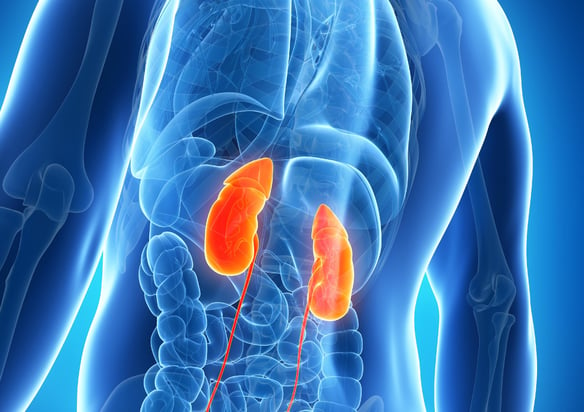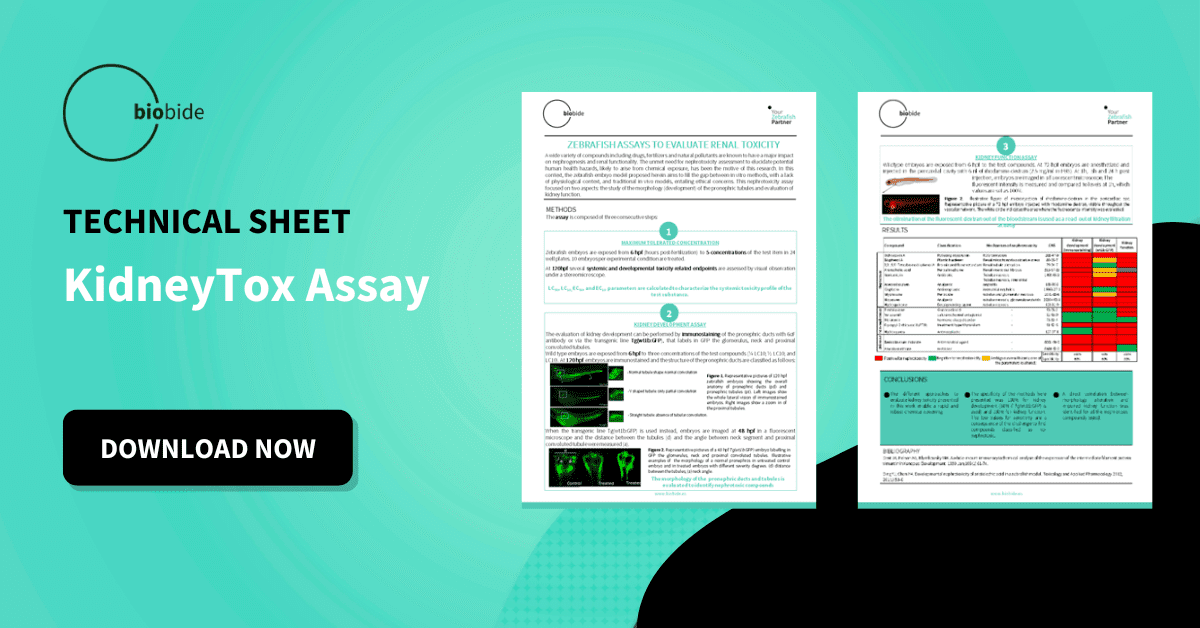A wide variety of compounds are known to have an impact on nephrogenesis and renal functionality. Consequently, there is a need for nephrotoxicity assessment to elucidate potential human health hazards that could lead to kidney malfunctions.
Over the last years, due to its versatility and advantages, zebrafish has emerged as a main vertebrate model system for in vivo High Content Screening (HCS) assays. In combination with automation and artificial intelligence (AI) technologies, large-scale screening assays can be applied to fields such as toxicology, safety or efficacy.
Zebrafish is an applicable and versatile experimental system for renal studies mainly due to the simplicity of its pronephros which can be readily studied in embryonic and larval stages and the structural and functional similarities with it In addition, the Zebrafish model complies with the 3R principles (Replacement, Reduction, and Refinement) for an more sustainable and ethical use of animals in research.

Kidney toxicity
Kidneys have a rich blood supply, have significant transporters activity, and act as a highly structured filtration network. Therefore, they are exposed to high concentrations of drugs or their metabolites which increases their susceptibility to drug-induced toxicity.
Developmental toxicity testing according to current international guidelines includes a series of screening tests that are mainly performed in mammalian models. However, these in vivo assays require large numbers of animals raising ethical concerns and are highly laborious and time plus cost consuming. In this context, the zebrafish can cost-effectively bridge the gap between High-Throughput Screening (HTS) in cellular in vitro models, lacking physiological context, and low-throughput in vivo models, such as rodents, that are closer to human biology, but entails ethical concerns and lower time and cost efficiency In this regard, zebrafish embryos and larvae comply with the 3R principles (Replacement, Reduction, and Refinement) under current legislation, and the High Content Screening (HCS) assays offer higher statistical power, in lower time and cost ratios.
Zebrafish as a high-throughput model for toxicity assays
The cost-effective and readily accessible zebrafish has been established as a main vertebrate model for human Disease Modeling, Drug Discovery, and Safety and Toxicity applications. Small size, ex-utero development, optical transparency, and rapidity of organogenesis render zebrafish embryos and larvae ideal for in vivo High Content Screening applications and large-scale assessment of compound effects. The optically transparent embryos and larvae fit into wells of microtiter plates and are amenable to automated microscopy applications using existing screening technologies.
Phenotype-based, cost-effective whole-organism chemical screening in zebrafish offers a variety of advantages including the identification of disease-modifying drugs without knowledge of a validated target and the simultaneous assessment of compound efficacy, toxicity, biodistribution, and pharmacokinetics within a vertebrate model system.
Why is zebrafish suitable to study kidney toxicity?
It has been shown that major zebrafish tissues and organs share many features with human counterparts at the anatomical, physiological and molecular levels, including brain, heart, muscles, kidney, and liver. Several zebrafish organs are used in toxicology studies, such as gonads, pharynx, thyroid, gut, liver, kidney, gills, and muscles based on evidence that toxicology can be transferrable to mammals and by the ease to test toxicities in zebrafish.
Zebrafish provides a valuable and unique model to study renal injury in conditions in which the complexity of organisms is preserved while the renal tract is significantly accessible when compared to currently available models. Kidney research using the zebrafish model reveals the overall conservation of nephron segment patterns and cellular composition in both embryonic and adult kidney structures, compared with those of other vertebrates, including humans.
The pronephros of the zebrafish larva consists of two nephrons with a fused glomerulus ventrally to the dorsal aorta. They are functional by 48 hpf (hours post fertilization) accomplishing the functions of blood filtration and osmoregulation. While several differences in nephron number between humans and zebrafish larvae exist, their homology results in a highly similar composition of single nephrons sharing numerous genetic, structural, and functional aspects with the mammalian nephron. In addition, kidney development and function essentially depend on the same orthologous genes for all vertebrate kidneys. Moreover, the drug-metabolizing enzymatic repertoire and metabolic xenobiotic profiles are highly similar to those in humans.
Therefore, studying the effect of compounds on the formation and function of zebrafish pronephros can aid in understanding the harmful effects that drugs may have on the development of renal cells in humans.
Zebrafish assays to evaluate renal toxicity
Zebrafish embryos and larvae are amenable to phenotypic screening approaches employing High Content Screening (HCS) using automated microscopy and image analysis Phenotypic readouts can comprise survival rates, overall morphology, physiological parameters, cell- and tissue-specific phenotypes, and behavioral phenotypes. In vivo phenotypic screens of vertebrates provide a significant advantage over classical in vitro assays as they do not require previous knowledge about biochemical pathways affected, thus allowing unbiased identification of drug candidates or toxicological effects of substances. Furthermore, they intrinsically involve processes of biodistribution, metabolism, and pharmacokinetics.
The nephrotoxicity assay focus on two aspects: the study of morphology (development) of the perinephric tubules and the evaluation of kidney function.
The assays can be focused on those two aspects:
- Kidney Development Assay: the evaluation of kidney development can be performed by immunostaining of the pronephric ducts. The morphology of the pronephric ducts and tubules is evaluated to identify nephrotoxic compounds.
- Kidney Function Assay: embryos are exposed from early stages to the test compounds. At around 3 days embryos are injected with the fluorescent rhodamine-dextran. The elimination of the fluorescent dextran out of the bloodstream is used as a read-out of kidney filtration activity.
As a result, these approaches enable a rapid and robust system for in vivo High-Throughput Screening (HTS) to evaluate kidney toxicity. In the case of using transgenic or mutant models available for kidney damage, these assays could be used for the efficacy of potential drugs, to confirm if they prevent or recover kidney damage.
Sources
- https://www.frontiersin.org/articles/10.3389/fcell.2020.00583/full
- https://journals.plos.org/plosone/article?id=10.1371/journal.pone.0082137
- https://academic.oup.com/toxsci/article/174/2/241/5732691?login=true
- https://www.mdpi.com/2076-3921/11/2/400/htm
- https://www.frontiersin.org/articles/10.3389/fped.2018.00183/full
- https://www.jove.com/t/61575/acute-kidney-injury-model-induced-by-cisplatin-in-adult-zebrafish
- https://www.intechopen.com/chapters/69752
- https://journals.physiology.org/doi/full/10.1152/ajprenal.00386.2004
- https://pubs.acs.org/doi/10.1021/acs.chemrestox.9b00335
- https://www.sciencedirect.com/science/article/pii/S0085253816003811





